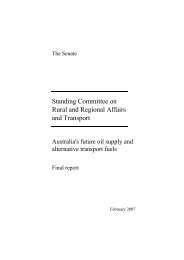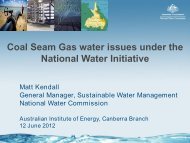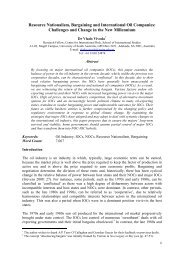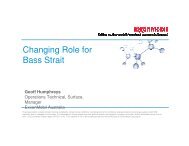Jun 2007 - Australian Institute of Energy
Jun 2007 - Australian Institute of Energy
Jun 2007 - Australian Institute of Energy
Create successful ePaper yourself
Turn your PDF publications into a flip-book with our unique Google optimized e-Paper software.
Emissions Trading: International<br />
and domestic developments<br />
Summary by Tony Vassallo, AIE Sydney Branch<br />
Presentation to Sydney Branch (hosted by Blake Dawson Waldron) on 2 April <strong>2007</strong><br />
Tony Beck, Coordinator <strong>of</strong> the Australasian Emissions Trading<br />
Forum (AETF), had just returned from the Point Carbon<br />
Conference in Copenhagen in mid-March. He started the<br />
presentation with a summary <strong>of</strong> the global emissions market,<br />
which has seen explosive growth since early 2006. This growth<br />
has been driven by the Kyoto Protocol coming into force, the EU<br />
emissions trading scheme (Phase 1) and both state and voluntary<br />
schemes in the USA and <strong>Australian</strong> markets. In millions <strong>of</strong><br />
tonnes <strong>of</strong> CO2 equivalent, the 2006 total <strong>of</strong> 1,600 was double<br />
the 2005 total, with a value <strong>of</strong> over A$35 billion in 2006. The<br />
EU scheme comprised 62% and the CDM (Clean Development<br />
Mechanism) just under 35% <strong>of</strong> the CO2 equivalent totals.<br />
The EU scheme covered more than 12,000 installations. The<br />
Phase 1 pilot scheme is now over-supplied, but the Phase 2<br />
scheme (2008–2012) has much tighter caps and is trading at<br />
about A$27/tonne at the moment. In 2006, between three and<br />
five million tonnes per day were traded. The Phase 3 scheme<br />
is due to continue beyond 2012, and early trades have already<br />
started with a 2013 delivery <strong>of</strong> A$32/tonne.<br />
The CDM scheme has approximately 570 registered projects<br />
delivering 780 million tonnes <strong>of</strong> abatement. There are another<br />
1,000 projects in the pipeline. There is a diverse mix <strong>of</strong><br />
projects, with biomass energy, hydro, wind, energy efficiency<br />
and agriculture accounting for three-quarters <strong>of</strong> the projects.<br />
There is strong demand for the CDM projects, especially from<br />
the EU, Japan and Canada, and capital markets are already<br />
responding. The majority <strong>of</strong> projects are in India (33%), Brazil<br />
(16%), Mexico (13%) and China (8%). The main countries<br />
investing in these projects are the UK (35%), The Netherlands<br />
(17%) and Japan (11%).<br />
Figure 1: Australia’s emissions pr<strong>of</strong>ile<br />
Mr Beck also covered activities in the USA, where the cap<br />
and trade scheme across nine north-eastern states is set to<br />
start on 1 January 2009. Five other states (California, Oregon,<br />
Arizona, Washington and New Mexico) are also planning a<br />
similar scheme. The Chicago Climate Exchange is operating a<br />
voluntary trading scheme, which the <strong>Australian</strong> company AGL<br />
has already joined. There is a substantial change in attitude<br />
occurring in the USA and, coupled with congressional pressure,<br />
there is likely to be a greater engagement in emissions trading<br />
in the United States in the next three to five years.<br />
Anthea Harris, Project Leader for the National Emissions<br />
Trading Taskforce (NETT) provided an update on the progress<br />
on the state-based National Emissions Trading Scheme (NETS)<br />
design. The scheme is supported by all <strong>Australian</strong> state and<br />
territory premiers and chief ministers. On 9 February <strong>2007</strong>,<br />
they announced that NETS will commence by the end <strong>of</strong> 2010<br />
if the Commonwealth does not agree to implement an alternative<br />
scheme. The states and territories, as well as the Labor Party at<br />
a national level, are committed to a 60% reduction in national<br />
emissions by 2050.<br />
The scheme will initially apply to all power generation facilities<br />
emitting more than 25 thousand tonnes <strong>of</strong> CO2 equivalent<br />
per year from 2010, with expansion to cover all stationary<br />
energy systems above 25 thousand tonnes, as well as fugitive<br />
emissions (underground coal mines, gas production, processing<br />
and transport) and gas retailers (imputed emissions) in 2013. A<br />
review <strong>of</strong> non-covered sectors will be undertaken in 2014.<br />
The scheme is essentially a ‘cap and trade’ design, where<br />
emissions are capped at some level in each period and permits<br />
to emit greenhouse gases are issued for that period. There is a<br />
penalty for non-compliance which<br />
underpins a value for emissions,<br />
and scheme participants can trade<br />
these permits among themselves<br />
with prices set by the market.<br />
The scheme is likely to be based<br />
on 10 years <strong>of</strong> known firm caps<br />
with gateways for 10 further years<br />
beyond firm caps. The firm caps<br />
will be extended annually, with<br />
gateways updated every five years,<br />
extending them for a further five<br />
years. These gateways provide the<br />
limits within which firm annual<br />
caps may be extended. The permits<br />
will be an annual, secure property<br />
right, date stamped with the year in<br />
which it first became valid. While<br />
unlimited banking <strong>of</strong> permits will<br />
be allowed, borrowing is not.<br />
33 EnErgy nEws Vol 25 no. 2, <strong>Jun</strong>e <strong>2007</strong>

















